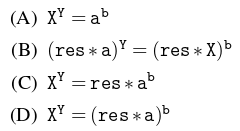Top MCQs on Algorithms in DSA with Answers
Question 41
The infix expression A + (B - C)* D is correctly represented in prefix notation as
Question 42
Consider the following table
Algorithms Design Paradigms
(P) Dijkastra’s Algorithm (i) Divide and Conquer
(Q) Strassen’s Matrix Multiplication (ii) Greedy
(R) Fibonacci numbers (iii) Dynamic Programming
Match the algorithm to design paradigms they are based on:Question 43
The following function computes XY for positive integers X and Y.
C
Which one of the following conditions is TRUE before every iteration of the loop

int exp(int X, int Y)
{
int res = 1, a = X, b = Y;
while ( b != 0 )
{
if ( b%2 == 0)
{
a = a*a;
b = b/2;
}
else
{
res = res*a;
b = b-1;
}
}
return res;
}

Question 44
Consider the following pseudo code, where x and y are positive integers.
begin
q := 0
r := x
while r >= y do
begin
r := r – y
q := q + 1
end
end
The post condition that needs to be satisfied after the program terminates isQuestion 45
Given an array that represents elements of arithmetic progression in order. It is also given that one element is missing in the progression, the worst case time complexity to find the missing element efficiently is:
Question 46
The cube root of a natural number n is defined as the largest natural number m such that m3 ≤ n. The complexity of computing the cube root of n (n is represented in binary notation) is:
Question 47
The minimum number of arithmetic operations required to evaluate the polynomial P(X) = X5 + 4X3 + 6X + 5 for a given value of X using only one temporary variable.
Question 48
The minimum number of comparisons required to determine if an integer appears more than n/2 times in a sorted array of n integers is
Question 49
In a complete k-ary tree, every internal node has exactly k children. The number of leaves in such a tree with n internal nodes is:
There are 49 questions to complete.
Last Updated :
Take a part in the ongoing discussion